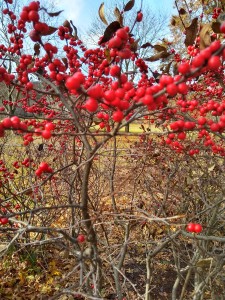
I am not a stamp collector and being a slave to the electronic communications that dominate all of our lives, I rarely send “snail mail” any more. When I do, I like to use stamps that make a statement, especially a botanical statement. This season I love the Winter Berries Forever stamps issued by the U.S. Postal service.
The series of four stamps, created by botanical artist Steve Buchanan, depict four native species, winterberry or Ilex verticillata; juniper berry or Juniperus communis, American beautyberry, also known as Callicarpa americana; and soapberry know to its botanical friends as Sapindus saponaria. With berries in vibrant red, dark blue, eye-catching violet, and gold, the plants light up the landscape during the dark months and feed the birds, all at the same time. All have the best traits of native species: toughness, hardiness and the ability to get along with minimal human assistance.
I covet winterberry holly, also sometimes known as black alder, coralberry and Michigan holly. Unlike the more common evergreen hollies that are ubiquitous during the winter holidays, winterberry loses its non-prickly leaves in the fall, the better to display its scarlet berries. Left to its own devices in its native eastern United States, winterberry holly will grow six to ten feet tall and wide. Cultivated varieties are generally smaller and can be pruned to keep them in proportion to their surroundings. I have seen winterberries massed in a nearby park, and they are dramatic, especially in December, when so many trees and shrubs are bare. Flower arrangers often use them in winter displays as well.
Winterberry is not one of those species that is treasured by the horticultural cognoscenti and spurned by everyone else. Many varieties are available commercially. If you buy one, remember that you really need to buy two—a male and a female—to produce the lovely berries. Fortunately, plant tags and nursery personnel can usually provide this information. Sometimes the name helps. For instance, ‘Southern Gentleman’ is, as you might expect, a male holly. So is ‘Rhett Butler’. As in the movies, either variety can form a relationship with the lovely female ‘Scarlett O’Hara’.
Beautiful and adaptable, common juniper has virtues that belie the “common” references in its Latin and popular names. It is usually a branching shrub that can grow five to 10 feet tall, but has also been bred into lower, ground-covering forms. Its evergreen leaves are narrow and needle-like, and the bark is red-brown with an exfoliating nature. Juniper’s secret is that its “berries” are not really berries at all, but unique rounded cones that grow one third to one half inch wide. They appear in tight clusters and are a poetic shade of blue with a glaucous or waxy “bloom” on them. As alcohol aficionados can attest, those juniper berries provide the distinctive flavoring for gin. Woody plant guru Dr. Michael Dirr also notes that they have been used as a diuretic. Gin drinkers may know this already.
Someday I will buy an American beautyberry or callicarpa, another species that I have coveted for years. Native to the southeastern United States, the three to eight-foot shrubs have attractive green leaves that are three to six inches long and oval-shaped. The flowers are pinkish-purple and bloom in early to mid summer. Beautyberry is never really ugly, but it lives up to its name in the late summer and early fall when the stem nodes are encircled by fat clusters of eye-catching purple berries. Depending on the shrub’s location, the weather, and the hunger of local birds, the berries may persist well into winter. The branches really spice up indoor arrangements, but given the general barrenness outside, it may be better to leave them on the bushes.
Soapberry produces dramatic golden orange berries in October that persist through winter, like little points of light. The species depicted on the stamps is the wingleaf or winged soapberry, an evergreen tree that grows 20 to 40-feet tall and wide in its native range in the lower southern United States and tropical areas farther south. Needless to say, it is not winter hardy. However, gardeners in cooler areas, through USDA plant hardiness zone 6, can rejoice, because Sapindus drummondii or western soapberry will grow farther north. The berries are the same attractive golden color on trees that grow 25 to 30 feet tall and wide. Compound leaves are rich green in summer and turn golden in the fall, adding a season of interest. The Latin genus name means “soapy” and refers to the berries, which indigenous peoples mashed in water to produce a soapy cleaning liquid. While useful against dirt, the berries are also toxic to humans.
As postage sales have declined, the U.S. Postal Service has made a great effort to create stamps that are more interesting and colorful. They certainly piqued my interest with the Winter Berries Forever series. I am rather glad that my infrequent mailing habit will make my book of twenty stamps persist through the winter, just like the berries on their faces.

